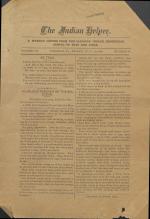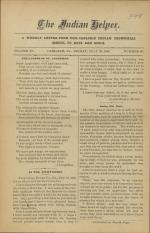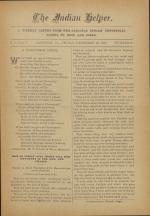Much of this issue of the newspaper was focused on the Outing Program, since many students were returning to the school from their country homes. The first page opened with the poem, "The Road to Wealth and Happiness," followed by an article entitled, "Is the Farming Which Our Boys Learn In the East of any Benefit to Them?," which compared East…
Sioux


The first page began with the poem, "Nobility," by Alice Cary followed by "A Letter from a Dear Old Lady of Eighty Years of Age," who shared her childhood recollections of life among the Tuscarora Indians camped on her family's land in Canada, some of whom became her playmates. This letter was continued on the fourth page. The second page…

The first page opened with the poem “Be True” followed by an article titled “A Carlisle Teacher on the Big Ocean,” about a trip aboard the Steamer Aurania dated July 6th, 1888 written for the Man-on-the-band-stand by “A Carlisle,” aka Miss Lowe. The article concluded on the fourth page. Page two featured a variety of small newsy paragraphs that…

The first page opened with a poem, “Good Advice,” followed by a fictional account of a conversation titled “Two Carlisle Boys at Pine Ridge Talk Over the Sioux Bill,” in which two former students, Zack and Tim, discuss the merits of signing the Severalty Act which had been presented to the Standing Rock Sioux Tribe. It concluded on the fourth…

The first page opens with an untitled poem. The next article titled “Peter Powlass,” contains a letter with news about events at the Oneida, Wisconsin Reservation written by former student, Peter Powlass. It is followed by “U.S. Congress,” that reported the schedule of the Fiftieth Congress. Page two contains news from the YMCA, the boys’…

The first page opened with a poem titled “Do We All?” followed by an article, “Do You Want to Get Rich?” about the value of saving little things. The next article, “Dr. Jackson at Our Missionary Meeting,” described the work of Sheldon Jackson among the Metlakahtla boys at the Sitka Industrial School in Alaska. It continued on the fourth page.…

The first page began with an untitled poem that opened with the first line “We can never be too careful,” followed by “Which Would You Rather Be a Spider or a Fly? / The White Man Like a Spider,” an account of Mr. Seger’s description of the idiosyncrasies of language translation. It continued on the fourth page. Page two featured news articles…

The first page began with a poem titled, “from The Memories of the Past and the Duties of the Present,” by John W. Woodside, followed by a reprint of a letter from former student Clarence Three Stars (Sioux) that reported conditions from his home titled “A Newsy Letter from Pine Ridge Agency: By an old Pupil of Carlisle who has been for Several…

The first page began with a poem titled “Listen,” reprinted from Harper’s Bazaar, followed by the publication of a letter received from Dolly Gould (Nez Perce) on her work at the Ft. Lapwai School under the title “Appreciation.” Felix Iron Eagle Feather’s (Sioux) letter from his Outing home was also included on the page. The second…

The first page opened with a poem by Fannie Bolton titled “It is Time,” followed by “The Experience of a Bull: A Child’s Version of the Recent Flood at Lewistown,” followed by “A Busy Indian Boy in the Country” which was Wallace Scott’s (Pueblo) description of his farm experience in Bucks County. Page two featured a notice of the new premium…

The first page opened with a Longfellow poem "The Ladder of St. Augustine” followed by James Black Hawk’s letter about the Fourth of July at Pine Ridge Agency titled “In the Right Spirit.” Page one also contained “Doing His Duty,” about how a seemingly unrecognized worker was promoted because of his hard work. It continued on page four. Page…

The first page opened with a poem “Little Moccasined Feet,” followed by the article titled “How Did There Come to be Any Coal?” that described the origin of coal. Page two opened with “Small Beginnings,” a litany of how Benjamin Franklin, Columbus, and others had their origins. “How One Conquers,” followed by “Luck and Labor,” as well as…

The first page opened with a poem "Willie’s First Boots” followed by “What Lawrence Learned,” about how Right Time and Right Place brought a boy success, reprinted from Wide Awake. Page two opened with a travelogue through California and Arizona to the Grand Canyon titled “Elevation – By Thermometer, and Rail.” Also on the page was a…

The first page opened with a poem "The Singer’s Alms: An Incident in the Life of the Great Tenor, Mario” by Henry Abbey, followed by the first installment in a series of articles written by the Man-on-the-Band-Stand about a Pueblo girl named Mollie. These stories were later published in book form in Stiya by Marianna Burgess, who…

The first page opened with a poem titled "A Christmas Carol by Eleanor W.F. Bates in Home Magazine. Next came a new installment of the series titled “How An Indian Girl Might Tell Her Own Story if She Had the Chance: Founded on Actual Observations of the Man-on-the-band-stand’s Chief Clerk” (continued from the previous week). In this…

A booklet of information and photographs assembled by the Carlisle Indian School for their 23rd year, circa 1902. Includes a short history of the school and the town and school demographic information. Includes pictures of arriving students, students during classroom and extracurricular activities, the buildings on campus, farmwork…

A souvenir booklet from the Carlisle Indian School, published for their 23rd year. A short description of the aims and goals of the school is presented. Images of students as they first arrived, as well as important visiting chiefs, are given, as are before and after images including those of Tom Torlino. Extracurricular…
![First Group of Female Students [Smaller Group], 1879 First Group of Female Students [Smaller Group], 1879](/sites/default/files/styles/views_taxonomy/public/image-photo/00309B%232.jpg?itok=ep1tLMr7)
Group portrait of the first female students, taken on the morning after their arrival on October 6, 1879
Note: This image is different from the more commonly seen one. Here there are only twelve people in the back row, not thirteen (it is not yet determined who is not present here). Sarah Mather and Charles Tackett are not included…
![First group of female students [version 1], 1879 First group of female students [version 1], 1879](/sites/default/files/styles/views_taxonomy/public/image-photo/CCHS_PA-CH2_012a.jpg?itok=inqzvuM7)
Group portrait of the first female students, taken on the morning after their arrival on October 6, 1879. Matron Sarah Mather is standing at left and interpreter Charles Tackett is standing at right.
This image appears in John N. Choate's Souvenir of the Carlisle Indian School (Carlisle, PA: J. N. Choate, 1902).
The…
![First group of female students [version 2], 1879 First group of female students [version 2], 1879](/sites/default/files/styles/views_taxonomy/public/image-photo/CIS-P-0037.jpg?itok=1bkZ7aqY)
Group portrait of the first female students, taken on the morning after their arrival on October 6, 1879. Matron Sarah Mather is standing at left and interpreter Charles Tackett is standing at left.
![First group of female students [version 3], 1879 First group of female students [version 3], 1879](/sites/default/files/styles/views_taxonomy/public/image-photo/00309B%231.jpg?itok=oo4QV0uj)
Group portrait of the first female students, taken on the morning after their arrival on October 6, 1879. Matron Sarah Mather is standing at left and interpreter Charles Tackett is standing at left.
![First group of male students (staggered pose) [version 1], 1879 First group of male students (staggered pose) [version 1], 1879](/sites/default/files/styles/views_taxonomy/public/image-photo/NAA_73344.jpg?itok=o5V_Akkb)
Group portrait of the first male students at the school in front the boys' dormitory. Some are standing on the balcony of the building, others are seated or standing on the porch or in front of the building. Interpreter Charles Tackett is standing at the far left.
These students came from the Pine Ridge and Rosebud agencies and…
![First group of male students (staggered pose) [version 2], 1879 First group of male students (staggered pose) [version 2], 1879](/sites/default/files/styles/views_taxonomy/public/image-photo/00308B.jpg?itok=Umf-UzrZ)
Group portrait of the first male students at the school in front the boys' dormitory. Some are standing on the balcony of the building, others are seated or standing on the porch or in front of the building. Interpreter Charles Tackett is standing at the far left.
These students came from the Pine Ridge and Rosebud agencies and…
![First Group of Male Students [Side Angle], 1879 First Group of Male Students [Side Angle], 1879](/sites/default/files/styles/views_taxonomy/public/image-photo/00309B%233.jpg?itok=IQLFZ3SV)
Group portrait of first male students at the school from the Pine Ridge and Rosebud agencies. They arrived on October 6, 1879. Richard Henry Pratt is standing at far left and interpreter Charles Tackett is standing at far right.
Note: This is a different view of the first male students than is more commonly seen. It was taken from…
![First group of male students [version 1], 1879 First group of male students [version 1], 1879](/sites/default/files/styles/views_taxonomy/public/image-photo/NAA_73347.jpg?itok=1fD_RVg5)
Group portrait of first male students at the school from the Pine Ridge and Rosebud agencies. They arrived on October 6, 1879. Richard Henry Pratt is standing at far left and interpreter Charles Tackett is standing at far right.
Note: The version of this photograph in the Richard Henry Pratt Papers at Yale University includes an…
